Rekindling the Romance
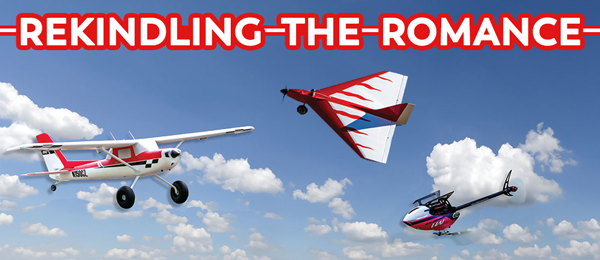
Rekindling the Romance
Beating back boredom, burnout, and frustration
Photos provided by the author except as noted
As seen in the May 2024 issue of Model Aviation.
Our hobby/sport isn’t any different from other aspects of life; things change, stagnate, evolve, and sometimes end. It goes for our jobs, relationships, hobbies, parenting—you name it. The key to surviving and thriving is recognizing it and adapting in ways that bring positive outcomes.
I’ve been involved in aviation in some form throughout my whole life. My first career was as a U.S. Army aviator, and the second half was writing about aviation modeling. During the U.S. Army portion, if things became frustrating, boring, or whatever, they had a cure for it: "Suck it up, mister. This is what you do!"
Well, that did seem to work, but it’s not what I wanted in my modeling life. In fact, editors don’t seem to talk to you that way, which is probably a good thing.
Change It Up
This has been my primary coping mechanism throughout the last 30-some years of doing this modeling, photographing, writing, building, flying, and reviewing business. It took me a while to recognize that it had become a business and that affected my enjoyment, or at least my outlook.
When I went to the field, I felt as though I had to shoot photos or take notes. If I went to my shop, I was always thinking about what might be worthwhile to take away for an article or a how-to piece. How could I enjoy my hobby time if I always thought of it as a job?
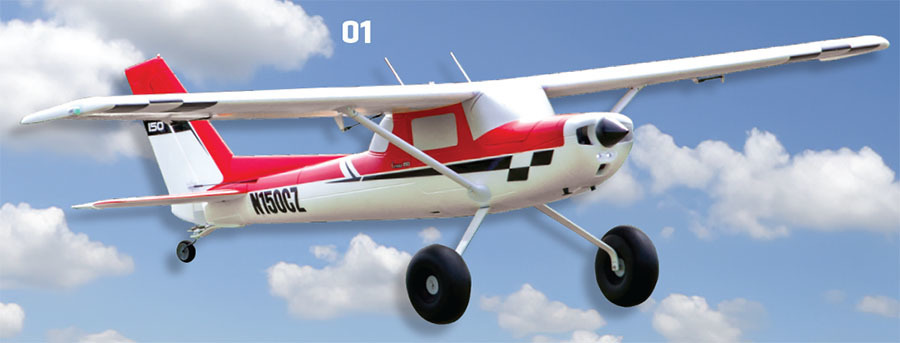
01. This giant-scale E-flite Carbon-Z Cessna 150T is nostress fun and good looking.
I had to change it up, start doing things just for the pure fun of it, and not think about whether there was an article in there hiding. Change it up! If you’re a club instructor and spend all of your time at the field instructing, step back and fly some yourself. If you don’t, it’ll become a chore. Balance your "work time" and "play time."
Nick Ziroli Sr.
Nick Ziroli Sr. is the king of Giant Scale designs and plans. If you had ever attended the Top Gun Invitational, you saw airplanes built from his plans. His name is synonymous with scale accuracy and precision. To this day, he is an absolute legend in Scale modeling. He is also one of the most gracious, kind individuals that I’ve had the pleasure of knowing.
I went to a small electric meet in upstate New York one weekend and noticed a man and his wife sitting at the far end of the flightline away from the main action. I walked down there and saw it was Nick and went over to say hello. I said something about being surprised to see him there. He laughed and told me about how he would go to these small meets sometimes just to get away from the business of modeling and have fun.
Of course, he was flying a small, electric-powered model of his own design, but he was just flying for fun. He wasn’t selling plans for it, kitting it, or anything other than having fun. He was anonymous. He was "changing it up" to keep himself centered and enjoying modeling. I ran into him a couple of different times throughout the years doing exactly that. This stuck with me as sage advice and I constantly refer to it.
Rich Uravitch
Top Gun wouldn’t have been Top Gun without people such as Rich Uravitch. He’s a Scale judge, builder, flier, and an expert at the highest level. At the same time, Rich flies a wide variety of things and all types of power systems. He never stagnates and has kept the fun in his business/hobby for a long time.
He has shared many tips with me throughout the years as we visited places such as the Toledo Show every bit of his advice to heart. I credit him with teaching me skills to cope with frustration and setbacks. He has written articles about dressing up a foamie ARF to make it look unique and to add more fun to owning an ARF. It doesn’t have to look like every other one at the field; he "changed it up."
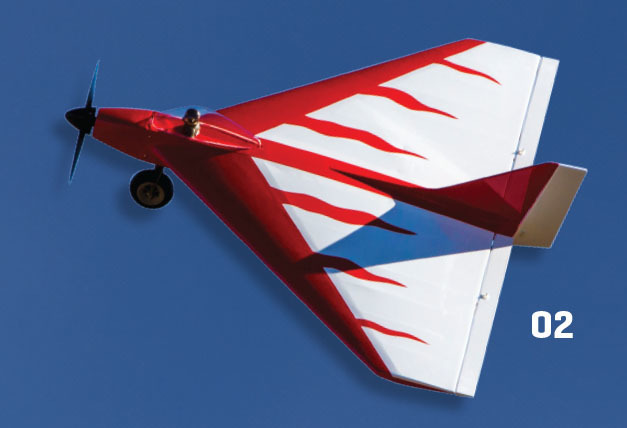
02. The Comet kit from Old School Model Works provided a nice change of pace.
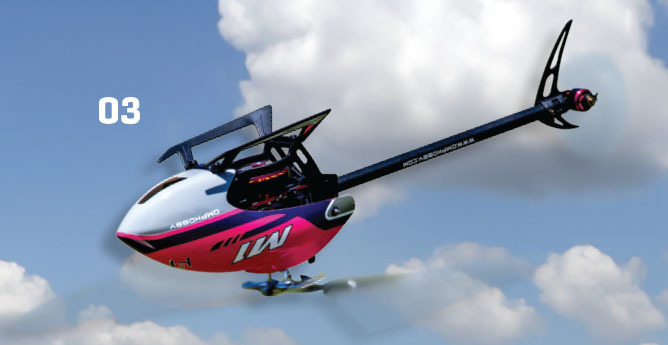
03. The author changes things up now and then with aircraft such as his OMPHOBBY M1.
You Don’t Have to Quit
You just have to change it up enough to get a break. Competition pilots find themselves consumed by practice, designing, building, and planning for the next competition. A friend started taking time off after the season and experimenting with small, electric-powered aircraft. This gave him the break he needed and he was ready when the competition season started again.
Another friend was heavy into Scale models. Some of these airplanes would take two or three years to finish. He would get bored and frustrated with the projects and sometimes they would be parked for months at a time.
Instead of doing something unrelated though, he started his next Scale project. Suddenly, he’d have three or four unfinished Scale airplanes stashed in the shop. He finally stepped back and decided to take a break and fly for fun. He got a couple of ARFs in various sizes and just enjoyed the flying side of things. He eventually returned to building but kept the ARFs for playtime.
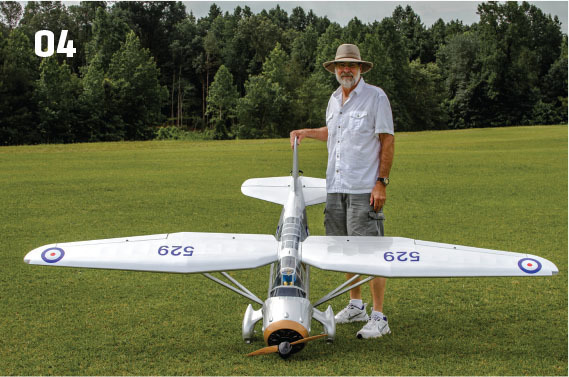
04. This Phoenix Model 10-foot wingspan Lysander is a beautiful airplane to fly, but the author mixes in smaller models between flights.
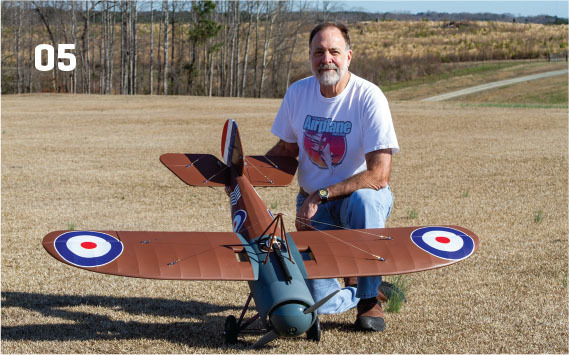
05. This 1/4-scale Bristol M1C from Seagull Models is so pretty that it’s like a piece of art in the air, but it’s a challenging airplane too. The author mixes in easier models between flights.
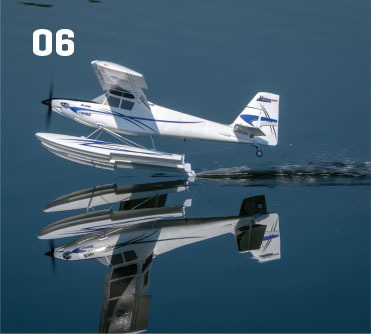
06. The E-flite Turbo Timber on floats is pure joy. Photo by John Kauk.
He found his balance this way and Scale building became fun again because it wasn’t all-consuming. Don’t make the mistake I’ve seen repeatedly, where someone gets burned out, sells all of their stuff, and six months later, they are shopping to get back into it.
Try Building
If you’ve never built a model beyond assembling an ARF or a foamie, try it. It doesn’t have to be a big balsa kit that takes months. There are plenty of small options that can be built quickly. The pandemic period rekindled a lot of interest in building, and some kit manufacturers have sprung up and are doing well.
Kits can range from laser-cut, quick-build kits to semi-ARFs, etc. YouTube is full of videos to help learn the necessary skills. Companies such as Stevens AeroModel and Old School Model Works are great places to start. Information and supplies are readily available.
Experiment! I belong to one club where experimentation is not only prevalent but highly encouraged. Our group spans the spectrum of experience, backgrounds, and ages. I’ve never been a big foam builder, but I have discovered a lot of fun can be had by experimenting with it, and, as one member said the other day, "What’s the worst that can happen? I’m out a couple of dollars in foam if it doesn’t work." He then went on to demonstrate a phenomenally good-flying P-38.
Several members are experimenting with 3D-printed airplanes of their own design. Some work, some don’t. The same can be said for many of our foam experiments, but the common theme is that we’re all having fun trying.
My Disc-Qualified is the first round biplane I’ve ever designed and flown. It’s not ready for prime time yet, but each flight and change gets better. For me, it’s put a lot of fun back into the hobby.
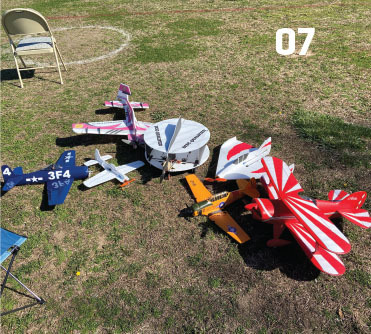
07. This is pure relaxation. The author’s arsenal at his park flyer club recently included a kit-built Bearcat (Ryan Aircraft), an E-flite Pitts, Hacker Edge 540, West Michigan Park Flyers Quasar, a foamie T-6, a foam-board mini Yak, and his self-designed Disc-Qualified.
Gas, Glow, Four-Strokes, Diesel, CO2, Electrics, and Rubber
It’s all good! If you’re tired of messing with four-stroke engines, try a gas engine. Big gas engines got you down? Try one of the small 15cc gas engines. Glow-fuel prices getting high? Try a gas engine.
Free Flight aircraft use a variety of power systems and each has its own challenges and rewards. I was getting bored with my wet engines right at the time that electrics started taking off in 1991.
I went to a big electric meet in Pennsylvania to see what it was about and fell in love. I continue to fly an occasional gas airplane, but electrics rekindled my love of the hobby.
Toss It on Water!
Try float-flying if you’ve never done it before. There’s just something sort of magical about flying off of water. Most of the time you don’t even need to buy a new airplane; just outfit something you have with suitable floats and give it a shot. Tons of information is available online, and specific forums on RCGroups can help you over the hurdle if you don’t have local help.
Sail It on Air
If you’re a power flier who is becoming a little bored, try sailplanes. You don’t need a four-meter Glass Slipper to find out what it’s about—there are tons of offerings to get you started. A popular, small, powered sailplane in our club is the E-flite UMX Radian. This single-cell-powered sailplane will shock you with its performance and only spans roughly 28 inches. Ten- to 20-minute flights combining power and soaring are the norm, even for novice sailplane fliers.
Variety Is the Spice of Life
Look at your hangar and see if everything is the same sort of aircraft. You don’t need a bunch of different models, but having more than one type of airplane can help fend off that boredom.
I love World War II fighters, but I don’t want to fly only that type. I keep a trainer, stunt model, a small sailplane, a small seaplane, a Giant Scale World War I fighter, and a giant sport-scale airplane in regular rotation. In between, I play with small helicopters and quadcopters.
The point is, I’m never bored or feel that I’m in a rut because I can change it up. Study the photos closely and look at the variety of aircraft that some of your clubmates show up with at the flying site. You don’t have to break the bank; just add to your collection when you can.
Clean, Repair, and Organize
Sometimes, just stepping back and looking at your hangar will give you answers to frustrations that cause you stress. Is your shop such a mess that you spend half of your time looking for tools or parts? Stop and clean it up. Organize your tools and parts.
Each time I do this, I find multiple packages of linkages, etc. that I bought because I thought I was out. It turns out that they were just lost in the mess, so I bought new ones. Organize things and return them to their respective places. It’ll save you aggravation and money in the long run.
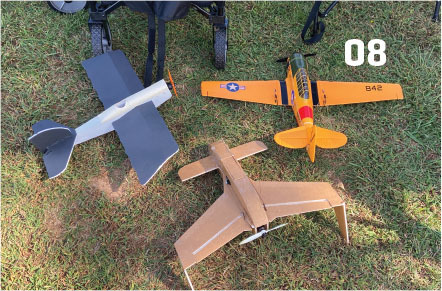
08. A couple of FliteTest plans-built airplanes and the no-name T-6 are fun changes.
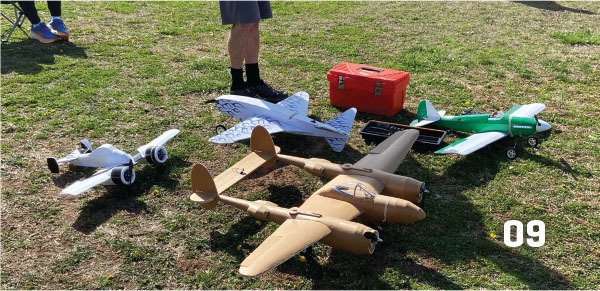
09. One of the author’s clubmates brought this variety of aircraft to the field. All are foam-board, plans-built models and each one is a success.
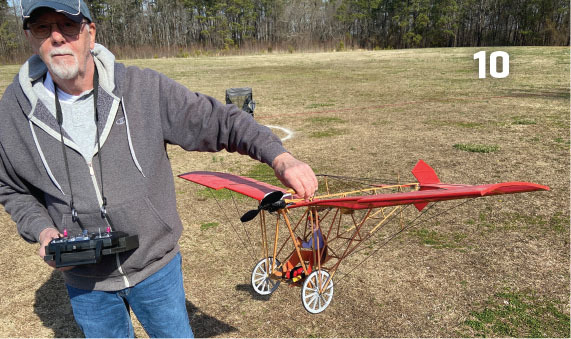
10. Clubmate Ernie Marsh shows off his Santos Dumont Demoiselle by Sig Manufacturing. It is a great-flying kit for calm mornings.
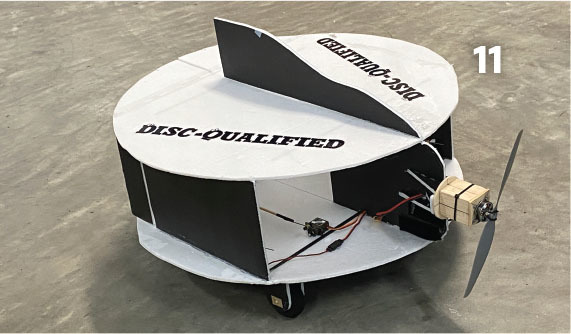
11. Disc-Qualified is still in the beta process. Its low-cost, low emotional investment adds a lot of fun to experimenting.
Do you have several models awaiting some repair? They can build to the point of frustration and discouragement. Dedicate a couple of days to working your way through the repairs. I do this twice a year and it really helps.
You’ll also find out that there is some magic that happens as things sit and that the damage isn’t as bad as you thought. Do one airplane at a time and have it ready to fly before starting the next. You’ll be surprised at how quickly it goes. Suddenly, your arsenal of flyable aircraft significantly increases.
Don’t Waste Your Time
We’re all busy with kids, spouses, friends, social obligations, work, and whatever. Time is valuable and not to be wasted, so don’t waste it doing something that you don’t enjoy. If you tried sailplanes and didn’t like them, move on.
Is Scale building too much work over time? Move on. I had an awful time learning to fly helicopters (ironic for a retired full-scale heli pilot) and I was constantly rebuilding wreckage. I got frustrated and angry, so I walked away. After some healing time, I returned to the challenge and eventually did learn to fly them. We’re involved in this because it’s fun; keep it that way.
Keeping It Fun
This is the bottom line: keep it fun! If you’re getting kids involved, make sure that it’s fun for them. Don’t berate and admonish them if they don’t enjoy your aspect of it. Find a facet of it that they enjoy and encourage it, even if it’s not your main interest. If they’re not interested in it at all, let them move on. Hobbies are fun and if they aren’t, you’re in the wrong one.
Parting Notes
Do whatever it takes for you to enjoy the things that you do in our hobby. Don’t quit because you become bored, frustrated, jaded, or whatever. Change it up (are you sensing a theme?) and try something new, if only as an experiment.
I often reflect on the advice from Nick Ziroli Sr. and Rich Uravitch and it’s been invaluable. My hobby has been a "job" for 30 years, but I keep the fun in it by doing many aspects beyond what I write about.
I go to the field or to flying meets and look for the ones who are having fun. They’re the innovators and forces who keep us going. Talk to them and see how many aspects of the hobby they’re involved in. You can learn a lot about keeping your love of the hobby alive just by listening.
SOURCES:
Horizon Hobby







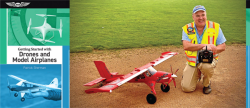
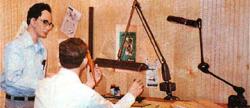
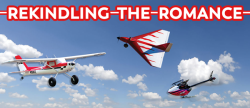
Add new comment